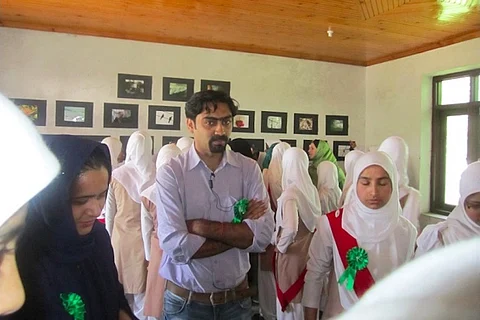

Teaching art to a group of young girls who have been warned against it from birth is quite a challenge. But Jeetin Rangher is no conventional artist and this wasn’t a typical girls’ school in a safe Indian city.
The school is located deep in Zainapura, in Kashmir’s Anantnag district where Jeetin was conducting an art workshop. He was there for a month before moving on to teach, once more, at the Banat school for orphaned girls in Srinagar.
“The girls were from an orthodox Sunni background which does not advocate art. It was difficult at first, but then I told them to look around and observe the beauty around them, in the Phulkari work on their dresses, or the way their kitchens were arranged. That’s how I started opening up their perception so they could understand that art is all around them and it is not a sin,” says Jeetin.
He has recently returned from Sri Lanka where he conducted several public art performances as well workshops organised by the Theertha Red Dot Gallery. He also conducted workshops for young girls in Sri Lanka’s Batticaloa district.
This Bengaluru-based artist studied painting at the Ken School of Art, completing his post-graduation in the subject from Bangalore University. After graduation, he began supporting himself by teaching private art classes while working on freelance projects and exhibitions.
It was in this period, in 2010, that he joined a group of artists in Art Karavan’s North India tour.
And it was on this tour that he first became acquainted with performance art and later met a friend (on a stopover in Srinagar) who told him about the school in Anantnag. Since then, Jeetin has been going to Kashmir every year to bring art into the lives of Kashmir’s youth.
Every year, he conducts art workshops for young orphan girls at the Banat school ,and for children with special needs at the Shafaqut school in Bimna near Srinagar. He also involves youth from the Faculty of Music and Fine Art of Kashmir University in performance art projects.
“In one of my first stints at Banat, I asked the girls to scribble on newspapers and then find shapes and forms in them. They found hearts, flowers and eggs, which was interesting because it was a conflict zone. That was when I realised how pure children are,” he recalls. At the same time, the girls would also share stories of army atrocities.
“This created a conflict within me because my father was in the Air Force. I started questioning the idea of a hero. It then pushed me to work more with them, understand what they were really saying,” Jeetin shares.

Image courtesy: Jeetin Rangher; Jeetin sits on a block of ice for four hours on a performance art project in Chandigarh
“I started telling them it is important to love and be loved and we started getting deeper into the art practice. These children had never seen or worked on any art, though it was part of their curiculum," he says.
By the end of his first stint, the girls had successfully put up an art show with paintings (beginning with oil pastels, to open them up) and installations.
“It was nice to see how they used bright and beautiful colours. For the installation, they worked on creating footsteps made of pebbles, which are aplenty in the region.”
Jeetin was careful not to give a political or social stance in the workshop because he felt it was necessary for them to understand art first: “It was important for them to see that they could do something with the material they have, that what they could do with that was also art.”
On the same trip, he worked with the local art college to put up a performance in Srinagar.
“The performance wad called ‘Painting Dull’. It was a commentary on the media, which I turned into the hero of my satire. I dressed up in newspapers and wore sunglasses with broken lenses. The lead characters were called ‘Mr. and Mrs. Big News’ because I observed that any news from Kashmir always makes headlines, and more often than not, it is propaganda," he says.
The performance also sought to raise awareness on the Dal Lake, which, Jeetin points out, has shrunk from 65 kms in diameter to 11 kms. “It has been encroached upon and what’s worse, the traditionally used waghu grass which decorated the tops of the shikaras has been replaced with flex hoardings which not only pollute the lake, but are also ugly.”
He explains that it was quite challenging to do a public art performance in the city because it was hard to predict the instances of violence that could erupt any time. Though he was able to secure permissions with the help of an art professor friend, he felt responsible for putting both himself and the artists at risk.
“Of course, those who came to watch the performance were also automatically putting their lives at risk. The situation in Kashmir is volatile, you never know how the army will react or how people will react. It is a strangely politicized zone and anything you do there is obvious, it has direct consequences,” he says.
However, Jeetin adds that the public has always been supportive.
“We were all set for a performance in July last year but we had to cancel because violence erupted a day before we were scheduled to perform,” he notes.
The violence also prevented him from conducting his annual workshop at the schools.
“This was the first time in six years that I had to leave Kashmir in the dead of the night by car. But I am going back to teach this year.”